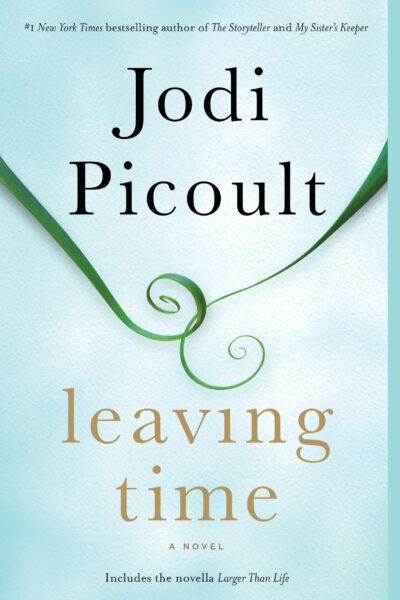
Leaving Time
Chapter 42: Alice
by Picoult, JodiAlice returns to bury her daughter Jenna’s remains, which are shockingly incomplete due to decomposition and scavenging. Despite her scientific understanding of decay, the reality of seeing only fragments of her child’s bones leaves her emotionally shattered. She had hesitated to return, fearing arrest, but her need for closure outweighed her fears. Yet, even as Jenna’s coffin is lowered, Alice feels disconnected, unable to fully accept this as her daughter’s final resting place.
After the burial, Alice visits her estranged husband, Thomas, at Hartwick House, where he has lived for a decade. She is stunned by his aged appearance, but his smile briefly revives the man she once knew. Their reunion is strained, as Thomas seems trapped in a delusional state, mistaking a Dr. Seuss book for a scientific article and referencing their daughter as if she were still alive. Alice realizes he is mentally unwell, unable to confront their shared past or Jenna’s death.
Thomas reminisces about Jenna as a toddler, recalling her clever antics, oblivious to the tragedy that befell her. Alice is heartbroken by his fragmented memories, which reflect a happier time before their lives unraveled. She mourns not only Jenna but also the loss of the man Thomas once was. Their conversation underscores the enduring pain of their shared history, leaving Alice with no solace or resolution.
Back at her motel, Alice grapples with unresolved guilt and fear, convinced the police will arrest her for an undisclosed crime. Instead, she is confronted by a mysterious woman with pink hair, whose name she struggles to recall. The encounter hints at another layer of Alice’s troubled past, leaving her—and the reader—with unanswered questions about her actions and the truth behind Jenna’s death.
FAQs
1. How does Alice’s scientific background influence her reaction to discovering her daughter’s remains?
Answer:
Alice’s scientific knowledge prepares her intellectually for the state of decomposition, as she understands how environmental factors like shallow graves and acidic soil accelerate the breakdown of a child’s remains. However, her professional understanding doesn’t shield her emotionally—she’s still horrified by the sparse bones (“a tangle of narrow bones”) that remain. This contrast highlights the tension between clinical knowledge and personal grief, showing how science fails to fully prepare her for the visceral reality of loss.2. Analyze the significance of Thomas’s mental state during Alice’s visit. What does it reveal about their shared trauma?
Answer:
Thomas’s dementia or delusion (believing a Dr. Seuss book contains encoded research) shows how trauma has fractured his grasp on reality. His fixation on academic rivalry and Jenna as a toddler suggests his mind has retreated to a safer time before their family’s collapse. This contrasts with Alice, who confronts their painful history directly. Their divergent coping mechanisms—Thomas’s escape into fantasy versus Alice’s unresolved guilt—illustrate how grief manifests differently, yet neither approach brings true closure.3. Why does Alice feel “stuck” even after Jenna’s burial? What does this reveal about closure?
Answer:
Alice expected burial to resolve her limbo between “reality and what-if,” but she remains emotionally paralyzed. This underscores how closure is more complex than physical evidence—she still grapples with guilt (“they know what I did”) and the symbolic weight of the incomplete remains (“This is still not my daughter”). The chapter challenges the notion that finding a missing person’s body automatically heals survivors, showing how unresolved questions and self-blame can persist beyond tangible resolution.4. How does the author use contrasting imagery to convey Alice’s emotional journey in this chapter?
Answer:
The chapter juxtaposes stark scientific descriptions (“porous” bones) with poetic metaphors (the grave as a “screaming mouth of the earth”) to mirror Alice’s dual perspective as both scientist and grieving mother. Thomas’s “smiley face” door sticker contrasts with his aged appearance, reflecting how memory distorts reality. The pink-haired woman’s “ghost breath” hair later evokes Jenna’s childhood, blending sweetness with haunting absence. These contrasts mirror Alice’s struggle to reconcile logic with loss.5. What thematic purpose does the pink-haired woman’s appearance serve in the chapter’s closing moments?
Answer:
Her arrival introduces ambiguity—Alice initially mistakes her for law enforcement, revealing persistent guilt, then associates her hair with Jenna’s love of cotton candy (“spook asem”). This liminal figure bridges past and present, justice and memory. As a potential spiritual guide or hallucination (given Alice’s exhaustion), she represents the unresolved nature of grief and the possibility of confronting truths Alice has avoided, setting up the narrative’s next emotional confrontation.
Quotes
1. “There is not very much left of my baby.”
This opening line immediately establishes the chapter’s emotional core—Alice confronting the fragmented remains of her daughter Jenna. The stark, clinical description contrasts with the profound grief, setting the tone for the chapter’s exploration of loss and closure.
2. “This was the closure I’d been waiting for, for years. How could I not go?”
Alice grapples with the paradox of seeking resolution while fearing it might be a trap. This quote captures the tension between her scientific rationality and maternal desperation, a key theme in her journey.
3. “Thomas so trapped by the past that he can’t accept the future.”
This observation about Alice’s husband reveals the chapter’s exploration of how trauma manifests differently—Alice physically fled while Thomas mentally retreated. The contrast between their coping mechanisms underscores the story’s psychological depth.
4. “She’ll be amazing,” Thomas says, answering his own rhetorical question. “Yes,” I say, my voice thick. “She will.”
This heartbreaking exchange shows Thomas living in a memory where Jenna still grows up, while Alice must acknowledge reality. The dual perspectives on grief—one suspended in time, one forced to move forward—create profound pathos.
5. “This was supposed to be what I needed to stop straddling the distance between reality and what-if. But I still feel rooted. Stuck.”
Alice articulates the chapter’s central conflict: the illusion that finding Jenna’s remains would bring peace. This realization that closure remains elusive even after physical evidence appears marks a pivotal emotional turning point.
